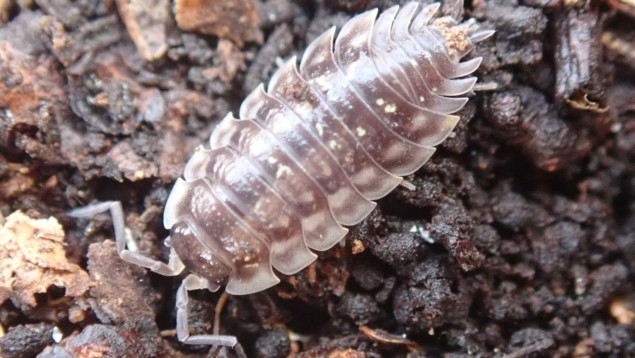
When I was a child I remember being fascinated by woodlice, some of which will roll-up into armoured, pea-sized balls when under threat. I grew up in Canada, and one thing that I noticed when I moved to the UK is that British woodlice take a lot more prodding before they roll-up than do their more sensitive Canadian cousins.
It turns out that woodlice are helping scientists develop a new way for monitoring the presence of metallic nanoparticles in the environment. Wolfgang Langbein and colleagues at the University of Cardiff have studied how woodlice absorb gold nanoparticles and how the metallic crystals move through their tiny bodies.
To do this the team used a newish technique called four-wave mixing microscopy. This works by firing light pulses at the woodlice – light that the gold nanoparticles absorb.
“By precisely pinpointing the fate of individual gold nanoparticles in the hepatopancreas of woodlice, we can gain a better understanding of how these organisms sequester and respond to metals ingested from the environment,” explains Langbein.
Environmental detection
In addition to boosting our understanding about how potentially toxic materials are taken up by living organisms, the research could lead to the development of new medical uses of nanoparticles and techniques for detecting nanoparticles in the environment. The research is described in Applied Physics Letters.
Water is a truly wonderous substance and it seems to be a never ending source of fascinating scientific discoveries. The latest involves water’s known ability to seal a hole in a leaky pipe. Katharine Jensen at Williams College in Massachusetts and colleagues have looked at a curious and poorly understood effect – that a small hole in a vertical pipe can be sealed by the water that is dripping out of it. This occurs even when there is a pressure difference that would tend to push water out of the pipe.
Dribs and drabs
The team drilled a 0.8 mm hole in a water filled pipe and watched what happened using a high-speed camera. As the height of the column of water above the hole fell, so did the pressure at the hole. As a result, the escaping water made the transition from a continuous flow to a dripping of droplets. After about 15 droplets exited the pipe, the next droplet stayed put – effectively plugging the hole.
The team modelled the effect in terms of the surface tension of the droplet, but that did not do a very good job of describing their observations. Then, inspired by the wobbling motions of trapped droplets, they team described the droplet as a mass and spring system. This model was much better at describing the team’s observations – and provides further insights into yet another amazing property of water.
Jensen’s team describes its findings in a preprint on arXiv and you can read more about the research in an article in Physics by Rachel Berkowitz.
- SEO Powered Content & PR Distribution. Get Amplified Today.
- Platoblockchain. Web3 Metaverse Intelligence. Knowledge Amplified. Access Here.
- Minting the Future w Adryenn Ashley. Access Here.
- Source: https://physicsworld.com/a/watching-gold-flow-through-woodlice-why-water-droplets-can-seal-leaky-pipes/
- :is
- $UP
- a
- ability
- About
- above
- AC
- addition
- After
- amazing
- and
- Another
- ARE
- AS
- At
- BE
- before
- being
- Better
- boosting
- British
- by
- called
- camera
- CAN
- Canada
- Canadian
- child
- colleagues
- College
- Column
- Common
- continuous
- could
- curious
- described
- develop
- Development
- DID
- difference
- effect
- effectively
- Environment
- Even
- Explains
- fascinating
- filled
- firing
- flow
- For
- from
- further
- Gain
- Gold
- good
- good job
- happened
- Have
- height
- helping
- Hole
- How
- HTTPS
- i
- image
- in
- individual
- information
- insights
- inspired
- issue
- IT
- ITS
- Job
- jpg
- known
- latest
- lead
- light
- living
- looked
- Lot
- made
- Mass
- massachusetts
- materials
- max-width
- medical
- Metals
- Microscopy
- Mixing
- model
- monitoring
- more
- motions
- move
- New
- next
- of
- on
- ONE
- Physics
- pipe
- plato
- Plato Data Intelligence
- PlatoData
- potentially
- precisely
- presence
- pressure
- property
- provides
- Push
- put
- Read
- remember
- research
- Respond
- result
- roll-up
- scientific
- scientists
- seems
- sensitive
- small
- So
- some
- Source
- spring
- stayed
- studied
- substance
- Surface
- system
- Take
- team
- techniques
- terms
- that
- The
- the UK
- their
- These
- thing
- threat
- Through
- thumbnail
- to
- transition
- true
- Uk
- under
- understanding
- understood
- university
- Watched
- watching
- Water
- Way..
- What
- which
- will
- Williams
- works
- would
- You
- zephyrnet













